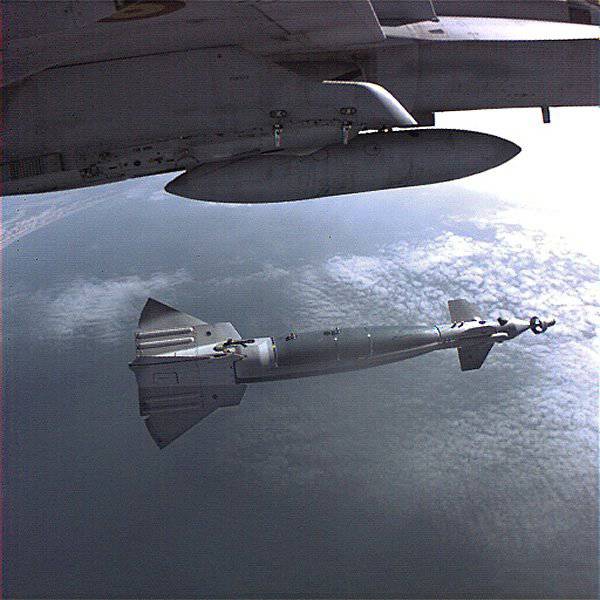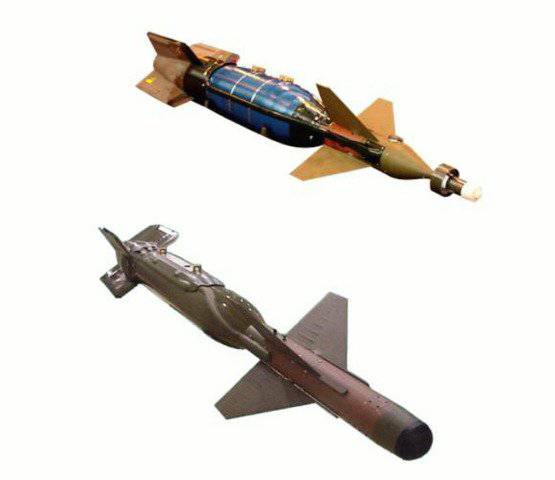In the United States developed an ultra-precise "wireless" bomb

As it became known from sources in the media, in particular from the message Defense Aerospace, the American company Raytheon has recently completed the development of the latest wireless control technology aviation bombs equipped with the Enhanced Paveway system. It also reports on the successful completion of trials for the application of this new and high-precision weapons using technology called WiPak. It is known that the system was tested using the EMB-314 Super Tucano training aircraft, produced by Embraer, a Brazilian company, on which it was installed. The future plans of the company Raytheon consider the possibility of installing the system on other aircraft, similar to the EMB-314 Super Tucano class.
Enhanced Paveway technology was developed by Raytheon with the participation of another equally well-known company Lockheed Martin and includes three elements of the system: 1. The control unit is installed in the cockpit. 2. Wireless signal transmitter. 3. A signal receiver placed on the aerial bomb itself in conjunction with the Enhanced Paveway system, which allows you to control its flight path. Also, this system is equipped with a set of steering mechanisms and high-precision guidance head for an aerial bomb.

According to representatives of Raytheon, one of the main advantages of the new WiPak technology is the ability to install it on almost anyone, even a civilian airliner. Moreover, the installation eliminated the need to change the design of the aircraft, making changes to its electrical circuit or to the system responsible for the management of conventional weapons. Unfortunately, all the rest, additional and more accurate details on this system remain secret.
One of the first samples of a controlled aerial bomb can be considered the UAB, created in Germany in the 1943 year, which received the designation PC 1400X, or its other name - Fritz-X. The development of this bomb was started back in 1938, by engineers Kramer (Kramer) and Herbert Wagner. During World War II, the question of the possibility of destroying enemy ships from the air was particularly acute. After 1942, attempts to attack air-defense targets usually covered with air by fighter jets and responding with heavy anti-aircraft fire in the majority of cases ended tragically for the Luftwaffe pilots. According to German gunsmith engineers, the only way out of this situation was to create a new and high-precision bomb weaponry that can be used from very high altitudes inaccessible to anti-aircraft fire and enemy fighter aircraft. In April, the 1943, a new bomb was tested and in July began to enter service with the Luftwaffe. Aiming a bomb on a target was carried out using a radio signal from heights beyond the reach of anti-aircraft artillery.
The first use of the PC 1400X was 23 August 1943, four bombs fired from Do-217 were damaged by two British corvettes, two days later another British corvette Egret was sunk and the Canadian naval destroyer Atamaskan was damaged. At the same time, all the planes that took part in the attack on the enemy ships returned without damage and without loss of personnel to their airfield. However, the greatest success of the PC 1400X is the bombing, carried out from a height of more than 8 000 meters, which led to the death of the Italian battleship "Rome" and the disabling of another battleship - "Italy". In the confrontation of the ship's anti-aircraft artillery and bomber aircraft for a while there was a turning point in favor of the latter.
To date, the UAB (Guided Aerial Bomb) is the most effective type of weapon, combining in itself a great weight of explosive and high accuracy of targeting a target that is not inferior in precision to targeting air-to-surface guided missiles and intended primarily for destruction as ground and surface objects of the enemy. Since guided bombs do not require the installation of powerful engines, this makes it possible to increase the mass of the explosive to an indicator close to 0.9-1 in the ratio of the mass of the warhead to the total weight of the aerial bomb. However, the guided bombs are inferior in speed to cruise guided missiles, and their use at low altitudes of the aircraft’s flight is a rather difficult task, given the high probability of all sorts of mistakes made during the first stage of bombing. Therefore, the UAB can not be considered either a supplement or replacement of guided cruise missiles.
Information